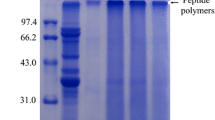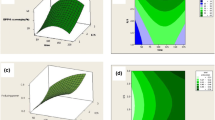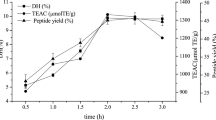Abstract
Shelf-life of dietary products and the need for health supporting functional ingredients often require components with high anti-oxidative properties. The study aimed at the characterisation of peptides with antioxidant properties from enzymatically hydrolysed soybean protein isolate. Soybean protein isolate was hydrolysed with a food grade pancreatic trypsin/chymotrypsin for industrial applications, ultrafiltered and the permeate was fractionated by size exclusion chromatography. Anti-oxidative properties of these fractions were tested in a Trolox®-equivalent-anti-oxidative capacity assay, which is based on the absorbance suppression of 2,2′-azinobis(3-ethyl benzothiazoline-6-sulfonate) radical cations by anti-oxidative substances at λ 414 nm. The amino acid compositions and sequences of the peptide fractions were determined by liquid chromatography and mass spectrometry analysis. Compared to the intact soybean protein isolate a peptide fraction with an anti-oxidative capacity of 113 mg TEAC/g was obtained. This fraction was shown to be enriched in peptides smaller than 1 kDa with prevailing aromatic amino acid residues. Nine peptides derived from glycinin and β-conglycinin were sequenced by tandem mass spectrometry. The particular sequences were synthesized and assayed. The synthetic peptide analogue TTYY (β-conglycinin fragment 291–294) revealed significant radical scavenging properties of 13.6 up to 59.6% with 0.18–18 mM in a concentration dependent manner. Peptides from soybean protein isolate were shown to possess anti-oxidative capacities which might be linked to the presence of carboxy terminal tyrosine. These findings offer new functional application possibilities in nutrition, cosmetics and pharmaceuticals.





Similar content being viewed by others
Abbreviations
- ESI-MS:
-
Electrospray ionisation mass spectrometry
- HILIC:
-
Hydrophilic interaction liquid chromatography
- LC–ESI-MS/MS:
-
Liquid chromatography–electrospray ionisation tandem mass spectrometry
- NMWCO:
-
Nominal molecular weight cut-off
- OPA:
-
o-Phthaldialdehyde
- PES:
-
Polyethersulfone
- RP-HPLC:
-
Reversed-phase high performance liquid chromatography
- SEC:
-
Size exclusion chromatography
- TEAC:
-
Trolox® equivalent anti-oxidative capacity
References
Rodrigo R, Guichard C, Charles R (2007) Clinical pharmacology and therapeutic use of antioxidant vitamins. Fundam Clin Pharmacol 21(2):111–127
Victor VM, Rocha M (2007) Targeting antioxidants to mitochondria: a potential new therapeutic strategy for cardiovascular diseases. Curr Pharm Des 13(8):845–863
Bilska A, Wlodek L (2005) Lipoic acid: the drug of the futures? Acta Biochim Pol 52:656–671
Shoji H, Koletzko B (2007) Oxidative stress and antioxidant protection in the perinatal period. Curr Opin Clin Nutr Metab Care 10(3):324–328
Bounous G, Molson JH (2003) The antioxidant system. Anticancer Res 23(2B):1411–1415
Atmaca G (2004) Antioxidant effects of sulfur-containing amino acids. Yonsei Med J 45(5):776–788
Iwaniak A, Minkiewicz P (2007) Proteins as the source of physiologically and functionally active peptides. Acta Sci Pol Technol Aliment 6(3):5–15
Kitts DD, Weiler K (2003) Bioactive proteins and peptides from food sources. Applications of bioprocessess used in isolation and recovery. Curr Pharm Des 9(16):1309–1323
Maruyama N, Mohamed Salleh MR, Takahashi K, Yagasaki K, Goto H, Hontani N (2002) Structure-physicochemical function relationships of soybean beta-conglyxcinin heterotrimers. J Agric Food Chem 50:4323–4326
Pena-Ramos EA, Xiong YL (2001) Anti-oxidative activity of whey protein hydrolysates in a liposomal system. J Dairy Sci 84:2577–2583
Yokomizo A, Takenaka Y, Takenaka T (2002) Antioxidative activity of peptides prepared from okara protein. Food Sci Technol Res 8(4):357–359
Chen HM, Muramoto K, Yamauchi F, Nokihara K (1996) Antioxidant activity of designed peptides based on the antioxidant peptide isolated from digests of a soybean protein. J Agric Food Chem 44:2619–2623
Korhonen H, Pihlanto A (2003) Food-derived bioactive peptides-opportunities for designing future foods. Curr Pharm Des 9(16):1297–1308
Yamamoto N, Ejiri M, Mizuno S (2003) Biogenic peptides and their potential use. Curr Pharm Des 9(16):1345–1355
Chen I-C, Chang HC, Yang HW, Chen GL (2004) Evaluation of total antioxidant activity of several popular vegetables and Chinese herbs: a fast approach with ABTS/H2O2/HRP system in microplates. J Food Drug Anal 12(1):29–33
Georgi G, Pietsch C, Sawatzki G (1993) High-performance liquid chromatographic determination of amino acids in protein hydrolysates and in plasma using automated pre-column derivatization with o-phthaldialdehyde/2-mercaptoethanol. J Chromatogr 613:35–42
Cole RD, Stein WH, Moore S (1958) On the cysteine content of human hemoglobin. J Biol Chem 233(6):1359–1363
Merrifield RB (1963) Solid phase peptide synthesis. I. The synthesis of a tetrapeptide. J Am Chem Soc 85(14):2149–2154
Van Overveld FW, Haenen GR, Rhemrev J, Vermeiden JP, Bast A (2000) Tyrosine as important contributor to the antioxidant capacity of seminal plasma. Chem Biol Interact 127(2):151–161
Chen HM, Muramoto K, Yamauchi F, Fujimoto K, Nokihara K (1998) Anti-oxidative properties of histidine-containing peptides designed from peptide fragments found in the digests of soybean proteins. J Agric Food Chem 46:49–53
Nguyen SD, Jeong TS, Kim MR, Sok DE (2006) Broad-spectrum antioxidant peptides derived from His residue-containing sequences present in human paraoxonase 1. Free Radic Res 40(4):349–358
Deneke SM (2000) Thiol-based antioxidants. Curr Top Cell Regul 36:151–180
Wang W, Gonzalez de Mejia E (2005) A new frontier in soy bioactive peptides that may preventage-related chronic diseases. Compr Rev Food Sci Technol 4:63–78
Erdmann K, Cheung BW, Schröder H (2008) The possible roles of food-derived bioactive peptides in reducing the risk of cardiovascular disease. J Nutr Biochem 19(10):643–654
Block KI, Koch AC, Mead MN, Tothy PK, Newman RA, Gyllenhaal C (2007) Impact of antioxidant supplementation on chemotherapeutic efficacy: a systematic review of the evidence from randomized controlled trials. Cancer Treat Rev 33(5):407–418
Acknowledgment
We are grateful to acknowledge Mrs. Monika Klapperich, and Mr. Michael Möbius (Danone Research, Friedrichsdorf, Germany) for their excellent technical assistance.
Author information
Authors and Affiliations
Corresponding author
Rights and permissions
About this article
Cite this article
Beermann, C., Euler, M., Herzberg, J. et al. Anti-oxidative capacity of enzymatically released peptides from soybean protein isolate. Eur Food Res Technol 229, 637–644 (2009). https://doi.org/10.1007/s00217-009-1093-1
Received:
Revised:
Accepted:
Published:
Issue Date:
DOI: https://doi.org/10.1007/s00217-009-1093-1




